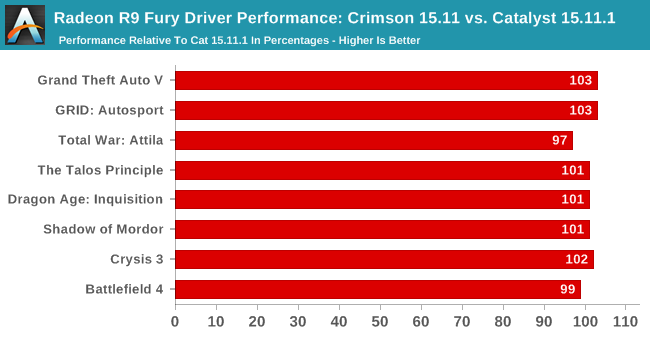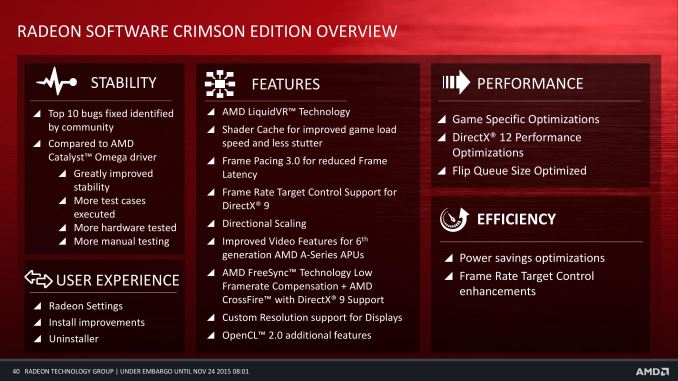AMD's Radeon Software Crimson Driver Released: New Features & A New Look
by Ryan Smith & Daniel Williams on November 24, 2015 8:00 AM ESTCrimson Performance
Last but certainly not least, let’s talk about performance improvements. Like the Omega driver before it, Crimson comes with a collection of performance improvements from AMD’s new driver branch. To preface this with caution, I don’t think anyone should be expecting massive system-wide performance gains – that’s all low-hanging fruit AMD picked long ago – but there’s plenty of room for some lesser optimizations along with game-specific optimizations.
AMD’s own numbers point to game-specific improvements of up to 20%, though it should be noted that AMD’s best-case numbers are on unreleased/beta games that have yet to be well-optimized in the first place. Otherwise AMD’s own numbers are far more tame, listing recently released games with gains between three and five percent.
To take a quick look at general performance, we went ahead and ran our GPU benchmark suite at 2560x1440 on our Radeon R9 Fury (vanilla), comparing the previous Catalyst 15.11.1 beta to the new Radeon Software Crimson 15.11 beta. The Fury and its underlying Fiji GPU is the newest product out of AMD, so it offers AMD the best opportunity to unlock any remaining performance in the architecture.

Overall the average performance gain at 2560x1440 is just 1%. There are a couple of instances where there are small-but-consistent performance gains – Grand Theft Auto V and Grid: Autosport stand out here – but otherwise the performance in our other games is within the margin of error, plus or minus. Not that we were expecting anything different as this never was pitched as a golden driver, but this does make it clear that more significant performance gains are going be on a per-game basis.
Final Thoughts
Wrapping things up, AMD’s development structure in the past year and going forward is one that has both been beneficial to the company and has brought with it its own drawbacks. By focusing feature releases around the end of the year driver, AMD is able to cut down on what parts of the driver they change (and thereby can possibly break) at other times of the year, and try to knock out all of their feature-related bugs at once. At the same time it makes the annual driver release a significant event, as AMD releases a number of new features all at once. However on the other hand this means that AMD has few features launching any other time of the year, which can make it look like they’re not heavily invested in feature development at those points. Then of course there’s the WHQL element, where for multiple reasons AMD hasn’t issued very many WHQL releases this year, and is something they’re seeking to change in 2016.
Looking under the hood there’s no single feature that’s going to blow every Radeon user away at once, but overall there are a number of neat features here that should be welcomed by various user groups. The Freesync Low Framerate Compensation changes should be of particular interest to Freesync users, while shader caching will improve shader loading performance across the board. Otherwise smaller fixes like the DirectX 9 improvements to CrossFire frame pacing, CrossFire Freesync, and framerate target control should be welcome news to APU and dual graphics users.
Meanwhile AMD’s radical overhaul of their control panel via the new Radeon Settings application will be quickly noticed by everyone. Though there’s plenty of room for interpretation on style and just how a good control panel is laid out, AMD has clearly put a lot of effort into cleaning up the layout of their control panel and it shows, as important options are no longer buried under multiple layers of menu trees. And on the performance front Radeon Settings is faster than Catalyst Control Center even on fast machines, and though we haven’t spent much time on covering it, AMD has also managed to speed up the installation process while they were at it. So all-told the Crimson release has something for everyone.
Ultimately I hesitate to ascribe too much of this to the Radeon Technologies Group too soon – this project has clearly been in the works longer than 3 months – but at the same time this is the RTG making their mark. It’s a new direction for AMD’s graphics group and a new look to match. And if the RTG can meet their stability, performance, and release goals going forward with the new Crimson driver, then they should be able to make 2016 a good year for the Radeon user base.


















146 Comments
View All Comments
psychobriggsy - Tuesday, November 24, 2015 - link
WCCFTech compared the previous AMD WHQL release to the new one.Anandtech compared the most recent AMD beta release to the new one.
Which one is more uesful, for users of non-beta drivers?
gamervivek - Tuesday, November 24, 2015 - link
WCCFTech compared these drivers as listed on their first page of the review.Drivers AMD - 15.11.1 Beta
AMD Crimson
So your question is moot.
Teizo - Tuesday, November 24, 2015 - link
You are going to take WCCF Tech's numbers over Anandtech? Holy heck, what is the world coming too....iamkyle - Tuesday, November 24, 2015 - link
Why are we even talking about this? Comparing reviews from a joke of a website being WCCFtech is laughable at best.yannigr2 - Tuesday, November 24, 2015 - link
Browsers crusing all over the place and Nvidia posting hotfixes every week only to make a month or more until fixing, Nvidia cards using 70-130W more power when system is sitting idle and running at over 144Hz that wasn't fixed yet, but you came in the conclusion that AMD drivers had serious problems in 2015 because of a memory leak that was fixed in less than 24 hours?YOU HAVE TO BE JOKING.
Chaser - Tuesday, November 24, 2015 - link
Vague. Baseless, fanboy, FUD. Maxwell mops the floor with AMD's winter space heaters.xthetenth - Tuesday, November 24, 2015 - link
I bought myself a 970. When I got a friend a 1440p monitor and a card to drive it I got her a 290. I'm getting progressively more jealous as I have to OC my card to keep up, it heats my room while running 2D because apparently more than one 1440p screen is difficult to push from desktop in tyool 2015 (nobody told my Surface, it does it just fine with a TDP less than the power my 970 wastes on integrated graphics), and best yet, for the past two or so weeks I can't tab out of a game without spending half my time waiting for my computer to stop being locked up. Best yet, I get to watch the past few years of AMD cards get steady performance boosts to the point early GCN cards have gone up an entire tier and wonder about how my card's going to get supported.All that for power savings I could get out of a $2.50 light bulb? That isn't even close to worth it. I've owned an 8800GT, 260, 560, 760 and the 970 and the past year's the worst showing I've seen from NV and the one that's made me decide to get AMD next time unless the performance gap is as big as between Fury and an OC 980 Ti, which I seriously doubt will be the case.
psychobriggsy - Tuesday, November 24, 2015 - link
Until you use a 144Hz monitor, or multiple monitors, it seems.xthetenth - Tuesday, November 24, 2015 - link
Yeah, unless I run a third party utility, I would probably be using more power overall with my 970 than a 290 because of how it decides it has to clock up to push 2D.looncraz - Tuesday, November 24, 2015 - link
No doubt you would.My R9 290, with two 1080p monitors, one 144hz (though I run it at 120hz) idles at around 96 to 102 watts, and pulls about 126 to 138 watts while playing video (a nice improvement with the Crimson driver, as I was previously pulling 142 to 152w on the same-ish videos).
In fact, this video card has only become better and better, whereas every nVidia card I've ever had seemed to age poorly. I have a 7870XT in my HTPC and it it easily ~30% faster playing Hitman and BF4 than when I first played either.